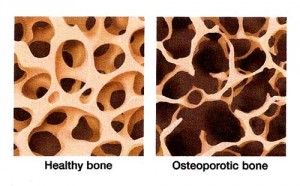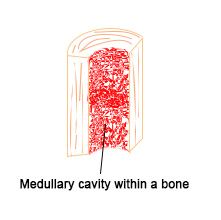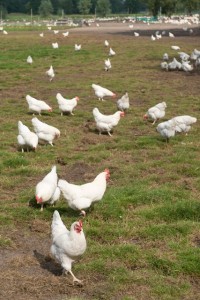Poultry Diseases
Calcium and Phosphorus Deficiency in Poultry
Also known as: Osteoporosis

This image illustrates the difference between normal healthy bone matrix and an osteoporetic bone. This image is from www.drwolgin.com
Both calcium and phosphorus are required for the synthesis of bone. These elements also play an important role in the nervous system, blood clotting and muscle contraction. Stored in bone they provide not only mechanical strength but also a reserve for periods of increased requirement (e.g., during egg laying) or periods of nutritional deficiency.
Calcium and phosphorus deficiencies can lead to abnormal skeletal development, or rickets in the growing chick, and osteoporosis in older birds. Although rickets is frequently associated with a deficiency of calcium, the condition is most likely to arise in situations of vitamin D deficiency (Wise, 1979). Osteoporosis results from calcium being removed from bone to meet other needs, and this causes porous and brittle bones (Long et al., 1984).
Newly hatched chicks need an immediate supply of dietary calcium for bone development. Since at this age chicks are osteoporotic, an absence of calcium or vitamin D makes this condition more pronounced.

The medullary cavity is the central area inside a bone where bone marrow is stored. Red bloods cells, white blood cells and fat calls are formed in the bone marrow and it has a vascular section which supplied the bone with nutrients and transports the cells around the body.
The first signs of a deficiency of calcium, phosphorus or vitamin D, or all of these, are:
- Lameness
- Stiff legs
- Ruffled feathers
- A reduction in growth
- Leg bones appear rubbery
- Joints become enlarged
- A calcium deficient diet may cause paralysis followed by death
In growing pullets, a calcium deficiency can result in increased general activity and environmental pecking (Hughes and Wood-Gush, 1973). The pullet’s requirement for calcium is relatively low during the growing period, but the bird still needs properly balanced phosphorous and calcium in its diet. When laying starts the need is increased at least four times, largely for the production of eggshells (Jacob et al., 2003) as the egg shell is composed primarily of calcium carbonate. Thus an early sign of calcium deficiency in laying hens is the production of thin and soft-shelled eggs.
Calcium is stored in the medullary cavity of the bone capable of rapid calcium turnover (See diagram). Whereas caged hens may suffer calcium depletion and brittle bones, birds on the ground tend not to suffer as they recycle calcium and phosphorus through coprophagy (Jacob et al., 2003).
The nutritional role of phosphorus is closely related to that of calcium. The ratio of dietary calcium to phosphorus affects the absorption of both these elements. An excess of either can interfere this process and cause production losses.
Low dietary phosphorus during lay can lead to elevated incidence of cage layer fatigue, reduced bone ash, increased severity of osteoporosis, and diminished bone strength (Webster, 2004).
In addition to its function in bone, phosphorus also plays a key role in carbohydrate metabolism, fat metabolism, and the regulation of the acid-base balance of the body (Jacob et al., 2003).
Control and Prevention of Calcium and Phosphorus Deficiency

Encouraging birds to do more exercise as in free ranging systems will improve bone strength and minimise the risk of osteoporosis.
Generally, the calcium content of poultry feeds of plant origin is low. Prevention of deficiency requires the adequate dietary provision of calcium, but young birds should not be fed a high calcium layer diet as an excess of dietary calcium can tie up phosphorus making it unavailable, and may result in rickets. The balance between calcium and phosphorous is key. Excess calcium in the growing period can also result in kidney damage, visceral gout, calcium deposits in the ureter and mortality.
If all feed for the birds is bought in, the feed mill will balance calcium and phosphorous in the ration. Farmers who mill and mix their own feed should be particularly careful to avoid causing deficiencies. There is a difference in requirement for calcium between laying hens and broilers with laying hens having a higher need for calcium of around 4g per day – equivalent to the weight of an average eggshell. Soluble limestone grit or oyster shell grit may be used to provide a source of calcium for laying hens (Reid and Weber, 1976). Calcium may also be provided in the form of mixed grit. Mixed grit contains soluble grit composed of limestone, oyster shell and other mollusc shells, and insoluble grit in the form of granite and flint. Particle size affects calcium availability with larger particles being retained for longer in the upper digestive tract and calcium being released more slowly. Oyster shell for example provides a slow release of calcium. This may be important for the continuity of shell formation (Jacob et al., 2003).
Dolomitic limestone should not be fed to poultry as it contains at least 10% magnesium, and can interfere with calcium absorption creating a deficiency, as opposed to alleviating it.
Breeding may be an effective way of combating osteoporosis. Some genetic lines may be more prone to osteoporosis than others (Bell and Siller, 1962 cited by (Webster, 2004)). A study was conducted which looked at the genetic heritability of bone index and strength in five generations of while leg horn end-of-lay hens. Some bone strength traits were been shown to be moderately to strongly heritable (Bishop et al., 2000).
Phosphorus in plant material is only partly available to the chicken, and for periods of the bird’s development can become unavailable. For this reason, poultry feeds need supplementation with phosphorus (Hopkins et al., 1987). Microbial phytases can be used in reduced-P layer diets containing feeds with high levels of P bound up in the form of phytate e.g. rice bran (Tangendjaja et al., 2002).
An interaction between particle size and phosphorus concentration occurs when chicks are fed diets deficient in phosphorus. For example, whilst food efficiency increases with fine and pelleted maize diets, calcium and phytate phosphorus retention are greatest with coarse maize diets (Kilburn and Edwards, 2001).
Treating Calcium and Phosphorus Imbalances
Provided irreversible damage has not been done to bone structure, altering the calcium content of the diet should be effective. Expert nutritional advice should be sought regarding therapeutic inputs of calcium to deficient birds. Damaged bone structure may be improved by encouraging exercise, provided the diet has been improved.
A calcium boost using water-soluble sources can help get the diet back into balance. Providing ad lib oyster shell will then allow hens to take what they need for maintenance.
Osteoporosis and Welfare
The welfare implications that stem from osteoporosis or rickets caused by calcium, phosphorus and or vitamin D deficiency causing weakened or brittle bones lead to spontaneous fractures generating pain, debility and mortality (Webster, 2004). Selecting birds with low body weight and feed intake but high egg production has created birds with weakened bones. The amount of calcium and phosphorus deposited in the shell is high in relation to the body weight of the bird (Whitehead and Fleming, 2000). Husbandry systems that allow birds to range freely, but free from hazards can be established to minimise welfare problems associated with osteoporosis. Allowing birds more exercise as in free range systems will improve bone strength (Whitehead and Fleming, 2000). Ensuring hens receive adequate calcium throughout their laying lives will maintain stronger bones and avoid breakages. For more information see Outdoor Ranging in the Poultry Welfare section of this website.
Good Practice Based on Current Knowledge
- Ensure that birds receive a supply of soluble and insoluble grit
- Care should be taken that the calcium component of feeds does not separate out and fall to the bottom of feed sacks and troughs


 American English
American English

Comments are closed.